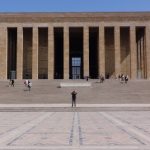South of Heykel in Ulus, Atatürk Bulvarı runs towards Opera Meydanı which takes its name from the Ankara State Opera House that stands here (Atatürk was a big opera fan). There are three main reasons to come here despite the heavy traffic and sometimes run-down surroundings: there are several important museums, Gençlik Parkı makes a great place to escape the city hassle and there is an abundance of cheap hotels.
One of the most prominent landmarks here is the glistening-white, four-minaret Melike Hatun Cami which was designed by Hilmi Şenalp and built in 2017. It is named after a woman believed to have lived in the 14th century and to have been a follower of Hacı Bayram Veli. Her modest tomb lurks unnoticed in streets to the rear. The Eynebey (İnebey) Hamam, still in business today, received financial aid from Melike Hatun before opening in 1502.
Around Opera Meydanı
The Opera Binası (Opera House) itself was originally built in 1933-34, but extensively remodelled in Modernist style in 1948 by the German architect, Paul Bonatz (1877-1956). A statue of the opera singer, Leyler Gençer (1928-2008), stands by the entrance.
Across the road and beside the Melike Hatun Cami Turkey’s finest Carpet Museum hides its light behind the unimaginative – not to mention unintelligible to tourists – title of the Vakıf Eserleri Müzesi (Objects of the Pious Foundations Museum, closed Mondays, admission free).
Here you can admire some of the extraordinary 17th, 18th and 19th-century carpets that used to adorn Turkey’s finest mosques but have been taken into safekeeping by the Vakıf, the organisation that cares for the mosques. Here, too, are displayed some of the items whose theft from the mosques resulted in the need for everything of real value to be removed from them, including pieces of woodwork from the world-heritage-listed complex at Divriği and a remarkable 18th-century covering for the Ka’aba in Mecca pilfered from the Damad İbrahim Paşa (Kurşunlu) Cami in Nevşehir and only returned to Turkey in 2004.
Next door is the grand Ministry of Culture and Tourism building,
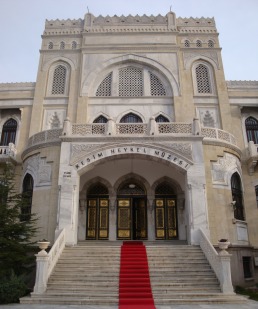 Across a nightmarish traffic intersection with busy Talatpaşa Bulvarı to the south the Museum of Painting and Sculpture (Resim Heykel Müzesi, closed Mondays, admission TL90) perches on Namazgah Tepesi and is housed in a delightful building offering a panoramic view over the city. It was designed in First National Architecture style by Arif Hikmet Koyunoğlu and opened in 1930.
Across a nightmarish traffic intersection with busy Talatpaşa Bulvarı to the south the Museum of Painting and Sculpture (Resim Heykel Müzesi, closed Mondays, admission TL90) perches on Namazgah Tepesi and is housed in a delightful building offering a panoramic view over the city. It was designed in First National Architecture style by Arif Hikmet Koyunoğlu and opened in 1930.
The Islamic prohibition on the creation of images of living things means that the history of Turkish painting has been condensed into the 19th and 20th centuries when attitudes softened, enabling artists to get to work. In effect, then, the Ankara Museum of Painting and Sculpture is as much a showcase for modern art as the better known İstanbul Modern in the Galataport.
Indeed, as you amble round the rooms here the same names will jump out at you – Feyhaman Duran, İbrahim Çallı, Hamit Görele, Fahrunissa Zeid, and of course Osman Hamdi Bey whose wonderful Woman in Fur and Weapon Merchant are on display here. A complete makeover in the 2010s has turned this into a gem of a museum for art lovers.
Sharing the same elevated location and in a building designed by the same architect, the Ankara Ethnography Museum also houses some wonderful items, especially when it comes to embroidery and woodwork – its piece de resistance is the exquisite 14th-century wooden mihrab removed from the Taşkınpaşa Mosque in Damsa, Cappadocia. In 1938 Atatürk`s body lay in state in this building before it was moved to the Anıtkabir.
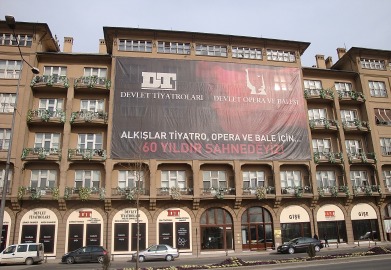 Vakıf Apartmanı now houses the Ankara Theatre and BalletIf you manage to make it back across the traffic intersection the big Gençlik Parkı makes a fine place to rest for a while and drink a tea in green surroundings. In İstiklal Caddesi, the street running immediately to the north, the huge Vakıf Apartmanı block was designed by Mimar Kemalettin Bey between 1928 and 1930. The novelist Ahmet Hamdi Tanpınar lived here for a while.
Vakıf Apartmanı now houses the Ankara Theatre and BalletIf you manage to make it back across the traffic intersection the big Gençlik Parkı makes a fine place to rest for a while and drink a tea in green surroundings. In İstiklal Caddesi, the street running immediately to the north, the huge Vakıf Apartmanı block was designed by Mimar Kemalettin Bey between 1928 and 1930. The novelist Ahmet Hamdi Tanpınar lived here for a while.
Those keen on modern architecture might like to stroll back to the Heykel in Ulus along Çankırı Caddesi, pausing to inspect some of the fine late 19th and early 20th-century buildings that line the street, many of them now housing banks. The Ziraat Bankasi (1926-29), the old Tekel building (1928) that now houses the Yunus Emre Vakfı and the old Osmanlı Bankasi building (1926) were all designed by the Italian architect, Giulio Mongeri, whose work can also be seen in St Anthony’s Cathedral on İstiklal Caddesi in İstanbul.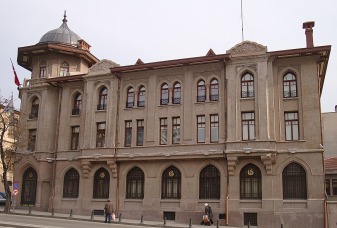 Old Tekel building on Çankırı Caddesi
Old Tekel building on Çankırı Caddesi
If you walk up Talatpaşa Bulvarı you will pass on the left the run-down and forgotten Yahudi Mahallesi (Jewish Neighbourhood), its synagogue hidden by high walls and only recognisable from the Art Nouveau stars of David on the gates. Across the road two houses which must have belonged to wealthier members of the congregation stand out for their good condition amid the general neglect.
A little further up the road is touristified Hamamönü (Altındağ). On the left-hand side of the road reconstructed Ottoman houses-turned-restaurants do a fine line in catering for henna nights, wedding parties, even baby showers. On the right-hand side of the road it’s more about eating, drinking and listening to a music in yet more faux Ottoman houses. In the midst of all this stands the 15th-century Karacabey Cami, a neat little brick-and-stone külliye with the tomb of the founder to the right and a çeşme (fountain) out front. The minaret is particularly attractive. Look closely at the portico and you’ll see that Roman pillars, capitals and other pieces of masonry have been extensively reused. Inside, the mosque is smaller than you’d expect. The architecture is in the early Ottoman style perfected in Bursa.
Sleeping
Opera Meydanı is home to a string of cheap places to stay aimed at travelling salesmen. They’re good choices for male travellers, less so for females. Some are complete fleapits with shared bathrooms, others are really quite nice although little seems to have been done to bring them up to modern hotel standards.
Transport info
Buses plough up and down Çankırı Caddesi all day long.
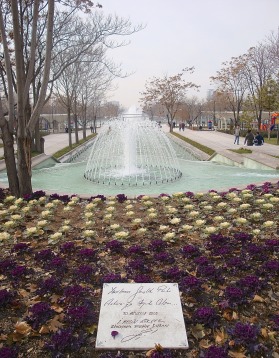 Gençlik Park in winter
Gençlik Park in winter
Nearby areas
Read more about the “Carpet Museum’: WHAT’S IN A NAME?

